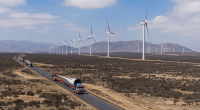Zambian President Hakainde Hichilema recently took part in the inauguration ceremony for the Itimpi photovoltaic solar power plant. In the face of drought, this 60 MWp facility is designed to meet the urgent need to diversify the electricity mix.
One year after the commissioning of the Riverside solar power plant, Zambian President Hakainde Hichilema was back in Kitwe for the inauguration of a second solar power plant built by Copperbelt Energy Corporation (CEC), through its subsidiary CEC Renewables. Covering an area of 80 hectares, the Itimpi plant consists of 109,144 bifacial monocrystalline solar modules and 200 inverters. This equipment provides 60 MWp of power, making it one of the largest solar photovoltaic plants in operation in East Africa.
Pleased to inaugurate the 60MW @CECinvestor Itimpi Solar Plant in Kitwe today,
especially as #Zambia & the region grapple with a severe power shortage that threatens energy, food & national security and economic development.
Let us get involved in this sector. pic.twitter.com/kaT2Tv5chc— Hakainde Hichilema (@HHichilema) April 10, 2024
At the inauguration ceremony in the Zambian province of Copperbelt, President Hichilema praised CEC’s efforts to help diversify the electricity mix and reduce greenhouse gas emissions. The Itimpi plant “is expected to offset 122,000 tonnes of carbon dioxide (CO2) emissions per year, complementing CEC’s efforts to support Zambia’s Nationally Determined Contribution (NDC)”, explained its Managing Director Owen Silavwe.
Financing through green bonds
According to Silavwe, the new power plant, equipped with solar trackers, will be capable of producing 130 GWh of electricity per year. Its construction required an investment of $53 million, financed by the first tranche of a $200 million green bond issued by CEC Renewables and listed on the Lusaka Stock Exchange.
Read also- Despite the crisis, Zambia and Zimbabwe relaunch the Batoka Gorge megadam
Following the inauguration of the new solar plant, CEC announced its intention to issue further tranches of the green bond “to finance future solar developments with associated storage technology, including a 126 MWp solar plant on the same site, scheduled for construction in 2025″. Inaugurated in February 2023, Kitwe’s first solar power plant has a capacity of 33 MWp. “The combination of our solar power plants at Itimpi and Riverside will produce a total annual energy output of 186 GWh,” explains Owen Silavwe.
The need to diversify the electricity mix
The construction of these solar power plants reflects the authorities’ desire to further diversify Zambia’s electricity mix. The East African country has an installed capacity of 3,030 MW, 2,393 MW of which is generated by hydroelectric power stations. The largest of these is the 1,319 MW Kariba plant, which Zambia shares with Zimbabwe. The state-owned Zambia Electricity Supply Corporation (ZESCO) obtains part of the electricity it distributes to the population and businesses from thermal (gas and coal) and solar power stations.
With droughts on the increase in Eastern and Southern Africa, Zambia is faced with a drop in the level of its dams and, consequently, in electricity production during the dry season. “The drought we have experienced this year is a wake-up call for the energy sector, which must be at the centre of the search for sustainable solutions that will guarantee a constant supply of electricity to our economy”, explains CEC’s Managing Director. ZESCO wants to further diversify its sources of production by focusing on solar energy, which can support the production of the dams during periods of severe drought.
Jean Marie Takouleu






